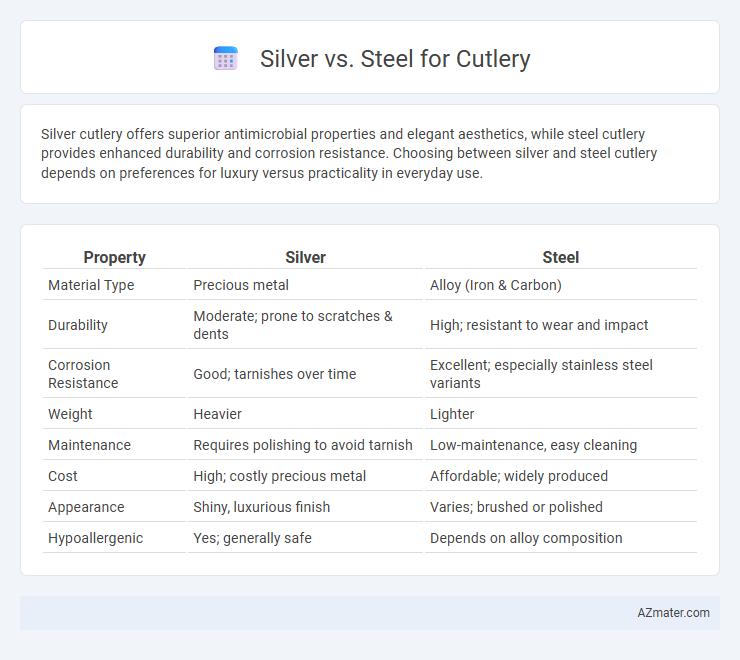Silver cutlery offers superior antimicrobial properties and elegant aesthetics, while steel cutlery provides enhanced durability and corrosion resistance. Choosing between silver and steel cutlery depends on preferences for luxury versus practicality in everyday use.
Table of Comparison
| Property | Silver | Steel |
|---|---|---|
| Material Type | Precious metal | Alloy (Iron & Carbon) |
| Durability | Moderate; prone to scratches & dents | High; resistant to wear and impact |
| Corrosion Resistance | Good; tarnishes over time | Excellent; especially stainless steel variants |
| Weight | Heavier | Lighter |
| Maintenance | Requires polishing to avoid tarnish | Low-maintenance, easy cleaning |
| Cost | High; costly precious metal | Affordable; widely produced |
| Appearance | Shiny, luxurious finish | Varies; brushed or polished |
| Hypoallergenic | Yes; generally safe | Depends on alloy composition |
Introduction to Silver and Steel Cutlery
Silver cutlery, often made from sterling silver (92.5% silver alloyed with copper), is prized for its elegant appearance and antimicrobial properties, making it a traditional choice for formal dining. Steel cutlery, typically crafted from stainless steel alloys containing chromium and nickel, offers superior durability, corrosion resistance, and ease of maintenance for everyday use. Understanding the distinct material compositions and characteristics of silver and steel cutlery helps in selecting the appropriate option based on aesthetics, functionality, and care requirements.
Historical Significance of Silver and Steel Utensils
Silver cutlery has long symbolized wealth and prestige, with its use dating back to ancient civilizations such as the Romans and Egyptians, valued for its antimicrobial properties and aesthetic appeal. Steel utensils emerged prominently during the Industrial Revolution, offering durability, affordability, and resistance to corrosion, which revolutionized everyday dining practices. The transition from silver to steel cutlery reflects both technological advancements and shifts in social accessibility to refined tableware.
Material Properties: Silver vs Steel
Silver exhibits excellent antimicrobial properties and a luxurious appearance but is softer and prone to scratching compared to steel. Steel, particularly stainless steel, offers superior strength, corrosion resistance, and durability, making it ideal for daily-use cutlery. The choice between silver and steel depends on balancing elegance with practicality in material performance.
Durability and Longevity Comparison
Silver cutlery offers moderate durability but is prone to tarnishing and scratching, requiring regular maintenance to preserve its appearance. Steel cutlery, especially stainless steel, is highly durable, resistant to corrosion, and retains sharpness over time, making it ideal for everyday use. The longevity of steel cutlery surpasses silver due to its robustness and minimal upkeep needs, ensuring long-term functionality.
Maintenance and Cleaning Requirements
Silver cutlery requires regular polishing to prevent tarnishing and maintain its shine, demanding careful hand washing with mild detergents to avoid damage. Steel cutlery, particularly stainless steel, offers superior resistance to corrosion and rust, allowing for easy maintenance through dishwasher-safe cleaning and minimal polishing. Proper drying of steel cutlery prevents water spots, while silver pieces benefit from storage in anti-tarnish cloth or bags to prolong their pristine condition.
Aesthetics and Design Versatility
Silver cutlery offers a timeless elegance with its lustrous sheen and intricate craftsmanship, often featuring ornate designs that enhance formal dining settings. Steel cutlery, especially stainless steel, provides sleek modern aesthetics and greater design versatility, accommodating minimalist to contemporary styles with durable finishes. The reflective quality of silver highlights traditional luxury, while steel's adaptability allows for varied textures and shapes, making it suitable for both casual and sophisticated tablescapes.
Health and Safety Considerations
Silver cutlery offers natural antimicrobial properties that reduce bacterial contamination, making it a safer choice for health-conscious users. Steel cutlery, especially stainless steel with 18/10 grade, provides corrosion resistance and durability but may harbor bacteria if not properly cleaned. Both materials require regular and thorough sanitation to maintain food safety standards and prevent potential health risks.
Cost Comparison: Upfront and Long-term
Silver cutlery typically has a higher upfront cost due to the precious metal content and craftsmanship involved, while steel cutlery offers a more budget-friendly initial investment. Over the long term, silver cutlery may require maintenance like polishing and can be prone to tarnishing, increasing upkeep costs compared to stainless steel, which is durable, corrosion-resistant, and often dishwasher safe, reducing ongoing expenses. Considering both purchase price and maintenance, stainless steel provides better cost efficiency for everyday use, whereas silver cutlery holds value as an investment and luxury item.
Environmental Impact and Sustainability
Silver cutlery has a higher environmental footprint due to intensive mining processes that consume significant energy and water, leading to habitat disruption and pollution. Steel, especially stainless steel made from recycled materials, offers greater sustainability with longer durability and easier recyclability, reducing waste and resource depletion. Choosing steel cutlery supports eco-friendly practices by minimizing carbon emissions and conserving natural resources compared to silver alternatives.
Choosing the Right Cutlery Material for Your Needs
Silver cutlery offers superior antibacterial properties and elegant aesthetics, making it ideal for formal dining and special occasions, whereas steel cutlery, particularly stainless steel, excels in durability, corrosion resistance, and everyday practicality. Choosing the right material depends on balancing factors such as maintenance requirements, budget, and intended use, with stainless steel favored for its low upkeep and long-lasting shine. Consider silver for its luxury appeal and antimicrobial benefits, while steel suits households seeking robust, versatile utensils.

Infographic: Silver vs Steel for Cutlery
 azmater.com
azmater.com